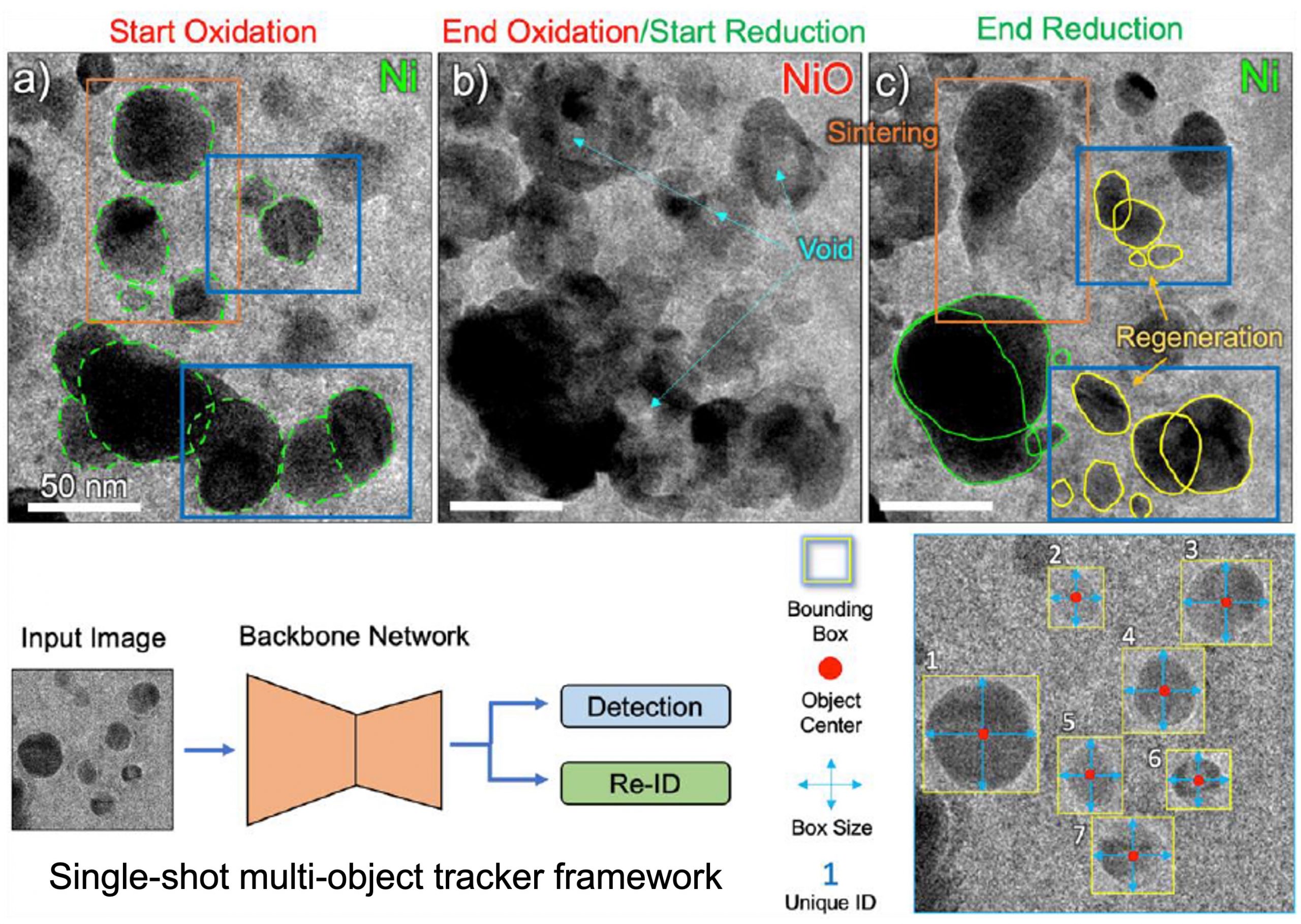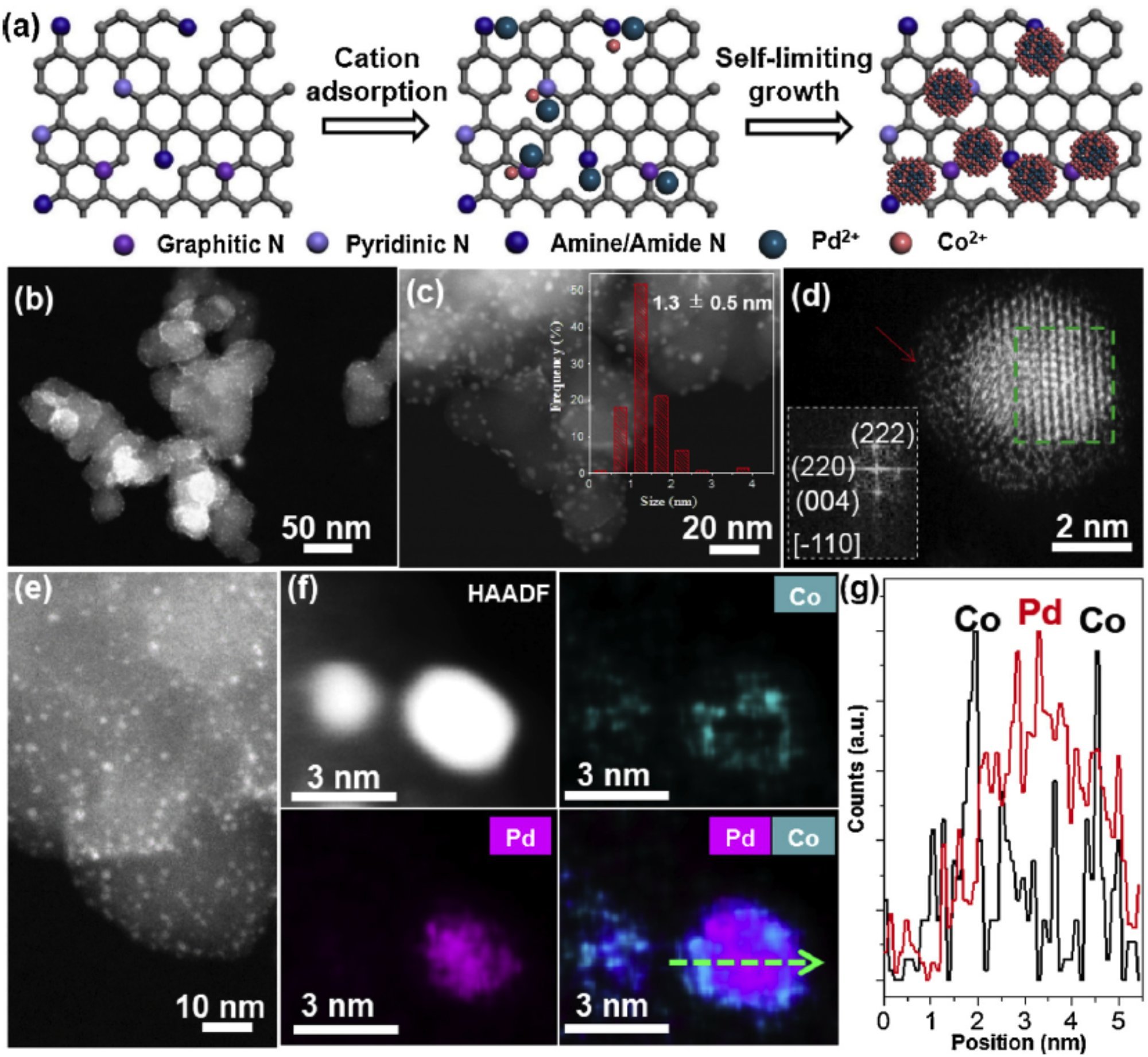

Quantitative gas-phase transmission electron microscopy: Where are we now and what comes next?
J. R. Jinschek, S. Helveg, L. F. Allard, J. A. Dionne, Y. Zhu, P. A. Crozier, MRS Bulletin 49, 2024, 174-183
Highlights:
- Provides a perspective covering exciting new technologies and methodologies of relevance for chemical and surface sciences in Gas-Phase Transmission Electron Microscopy (GP-TEM)
- Emphasized the benefit of implementing gas cells, quantitative TEM approaches using sensitive detection for structured electron illumination (in space and time) and data denoising, optical excitation, and data mining using autonomous machine learning techniques
R. Sainju, D. Rathnayake, H. Tan, G. Bollas, A. M. Dongare, S. L. Suib, Y. Zhu*, ACS Nano, 2022
Highlights:
- Oxidation of metal nanocatalysts plays a significant role in catalyst activation, operation, deactivation, and regeneration
- In situ ETEM video combined with phase segmentation directly correlates particle-level oxidation kinetics with structural evolutions
- A unified oxidation theory is established to reconcile size-dependent Ni nanoparticle oxidation

R. Sainju, S. Suib, C. Ding, Y. Zhu, Microscopy and Microanalysis, 2021, 27 (S1), 2216-2217.
Highlights:
- Unlike conventional sintering studies that rely mostly on measuring averaged nanoparticle size or the overall surface area, the nature of in situ ETEM offers direct real-time visualization of the nanoparticles’ evolution at the nanoscale in response to the different reactive gaseous environments
- Whether a nanoparticle was sintered or regenerated depends on the intricate interplays among the nanoparticle size, its surrounding nanoparticles, and the reaction conditions
- In-situ ETEM combined with deep learning-based computer vision holds the potential to register and scale up single-particle level analysis that is critical to the understanding of nanocatalyst regeneration

M. Hu, L. Jin, Y. Zhu, L. Zhang, X. Lu, P. Kerns, X. Su, S. Cao, P. Gao, S. L. Suib, J. He*. Applied Catalysis B: Environmental, 264, 2020, 118553
Highlights:
- Under temperature reduction (UTR) was found in nanoalloy synthesis.
- Stable, ultrasmall and clean Pd-based nanoalloys were synthesized through UTR.
- Excellent ethanol electrooxidation and hydrogenation performances were achieved.

M. Hu, W. Yang, H. Tan, L. Jin, L. Zhang, P. Kerns, Y. Dang, S. Dissanayake, S. Schaefer, B. Liu*, Y. Zhu*, S. L. Suib*, J. He*, Matter, 2, 2020, 1244-1259
Highlights:
- Template-free syntheses of mesoporous transition metal oxides are demonstrate
- Crystal interconversion results in highly crystalline frameworks
- Elimination of small molecules creates continuous porosity within oxides
- Unique surface-step defects boost the activity of porous oxides

Design and synthesis of highly active MoVTeNb-oxides for ethane oxidative dehydrogenation.
D. Melzer, G. Mestl, K. Wanninger, Y. Zhu, N. D. Browning, M. Sanchez-Sanchez*, J. A. Lercher*, Nature Communication, 10, 2019, 1-9
Highlights:
- Highly active MoVTeNbOx (M1) catalysts have been directly and selectively synthesized with the aid of complexing agents that control the activities of ionic intermediates
- The formation of highly corrugated side walls for our M1 exposes a large concentration of active sites, leading to an unusually high intrinsic ethane ODH activity
Formation of Oxygen Radical Sites on MoVNbTeOx by Cooperative Electron Redistribution.
Y. Zhu*, P. V. Sushko, E. Jensen, L. Kovarik, D. Melzer, C. Ophus, M. Sanchez-Sanchez, J. A. Lercher* and N. D. Browning*, Journal of the American Chemical Society, 139, 2017, 12342-12345
Highlights:
- We report a novel pathway for increasing the surface density of catalytically active oxygen radical sites on a MoVTeNb oxide (M1 phase) catalyst during alkane oxidative dehydrogenation
- The reduction of a small fraction of Te4+ to Te0 in the Te-M1 catalyst generates redox-active O− radical sites under catalytic operating conditions, without compromising the structural integrity of the M1 catalyst.
- The in-situ ESTEM observations identify complex dynamic changes in the catalyst on an atomistic level, highlighting a new way to tailor structure and dynamics for highly active catalysts

Y. Zhu*, N. D. Browning, ChemcatChem, 9, 2017, 3478-3485
Featured on the front cover of ChemcatChem and on MSA Update
Highlights:
- Gas environment effects on in-situ image quality and resolution are investigated experimentally and theoretically
- The absence of the extra inelastic noise owing to the annular collection mode of the ADF-STEM imaging allows the ESTEM imaging mode to maintain a good imaging SNR in gas
- Recent development in high-quality atomic ESTEM and other TEM advancements make it a promising in situ toolbox for investigating catalytic dynamics

Location of Co and Ni promoter atoms in multi-layer MoS2 nanocrystals for hydrotreating catalysis.
Y. Zhu, Q. M. Ramasse, M. Brorson, P. G. Moses, L. P. Hansen, H. Topsøe, C. F. Kisielowski and S. Helveg*, Catalysis Today, 261, 2016, 75-81
Highlights:
- Aberration-corrected STEM and EELS spectrum imaging were used to determine the location of Co and Ni promoter atoms in industrial-style hydrotreating catalysts
- Both Co and Ni promoter atoms occupy sites at all low-indexed edge terminations of hexagonally shaped multi-layer MoS2 nanocatalyst
- Successive MoS2 multilayers alternatingly expose Mo- and S-edge terminations in any of the low-indexed directions, providing promoted edge sites with different steric accessibility for the organic compounds in mineral oil distillates

D. Melzer, P. Xu, D. Hartmann, Y. Zhu, N. D. Browning, M. Sanchez-Sanchez and J. A. Lercher*, Angewandte Chemie International Edition, 55, 2016, 8873–8877
Highlights:
- Combination of quantitative analysis of rates with statistical analysis by HIM and HAADF-STEM allowed linking the macroscopic catalytic rates to the atomic level description of active surfaces for understanding selective oxidation catalysis on an atomistic level
- The lateral facets {120} and {210} expose crystalline positions related to the typical active centers described for propane oxidation; in contrast, the low activity of the facet {010} is attributed to stable M6O21 units connected by a single octahedron

Visualizing the stoichiometry of industrial-style Co-Mo-S catalysts with single-atom sensitivity.
Y. Zhu, Q. M. Ramasse, M. Brorson, P. G. Moses, L. P. Hansen, C. F. Kisielowski and S. Helveg, Angewandte Chemie International Edition, 53, 2014, 10723-10727
Highlights:
- We answered a long-standing question on the Co-promotor atomic position in the so-called “Co-Mo-S” hydrotreating catalyst
- Single-atom-sensitive EELS spectrum imaging and HAADF-STEM pinpointed that the Co atoms occupy sites at the (100) S edge terminations of the MoS2 catalyst
- Specifically, each Co atom has four neighboring S atoms that are arranged in a reconstructed geometry, which reflects an equilibrium state